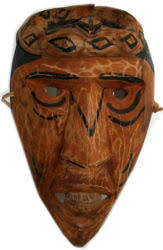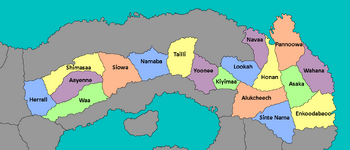| |||||||
| Anthem | "Flaming Heart" | ||||||
| Capital (and largest city) |
Anawabee | ||||||
| Demonym | Degalogesan | ||||||
| Government | Union of Autonomous Nations | ||||||
| Legislature | Grand Council | ||||||
| Currency | Wampum | ||||||
For the modern polity located on the former territories of Degalogesa, please see Mpakoala.
Degalogesa, formally the United Nations of Degalogesa, was formerly an extant nation in northern Dovani. After achieving independence from Dankuk, it operated as a tribal-based federal republic. It was later merged into North Dovani, and is located in modern Mpakoala.
Degalogesa would have a strong political impact on Mpakoala as a point of political contention over sovereignty and federalism. The autonomous tribal structure of government is seen as an innovative form of diversity in administration; and may be seen as the forerunner of the disastrous Ethnic Federalist policy of the late 50th century. However; whether this should be praised or criticized is a sensitive subject of contention among the post-Mpakoalan states and their citizens.
History[]

A traditional Degalogesee hard-carved mask
Prior to being conquered and colonised, the inhabitants of modern-day Degalogesa were only loosely connected to one another. Despite having somewhat similar origins, there was little shared culture, language or religion. Operating primarily as farming settlements and tribes, rival 'nations' often clashed with one another of land, food and other resources.
Around the third millennium, the area constituting Degalogesa was colonised by both Dranland and Hulstria and Gao-Soto. During this period, the native populations were severely persecuted and conflict between Degalogesee nations was minimal due to the mutual enemy of the colonisers.
Degalogesa was eventually granted independence and has since operated as a federation of 'nations'. Each nation has its distinct culture, beliefs, language and traditions though there are many similarities between the nations.
In the 4200s, ambitious politician Gawonii Sequoyah became Chairman of the Grand Council and set about introducing a series of reforms that effectively centralised economic-decision making and led to the introduction of a single Degalogesee currency (the Wampum).
He also put pressure on all nations to fully democratise their process for selecting Grand Council delegates and established a pan-Confederation army to replace the traditional tribal militias.
Degalogesa voted to merge with the newly-indepedent North Dovanian Federation in the mid 5th Millenium.
Government and politics[]
Degalogesa operated as a union of 'nations' – somewhat akin to tribes in other cultures. Each individual nation was almost entirely self-governing in many aspects, with the federal government in control of economic and security policy.
Government[]
The Grand Council was the governing body of Degalogesa, in which leaders from the nations would meet to make decisions on foreign affairs, trade and finance issues. Nations were allocated seats based on their relative population and were free to decide for themselves how to elect their representatives.
Administrative divisions[]

Degalogesa's eighteen nations
Degalogesa was is composed of eighteen separate nations, each with a distinct and somewhat unique culture of their own.
Culture[]
Naming Conventions[]
Traditionally, most Degalogesee did not use surnames however the arrival of Dranish colonisers saw an increase in their usage. Customs vary significantly between nations but a common theme is for a child to take their father's and/or mother's name as their surname(s).



